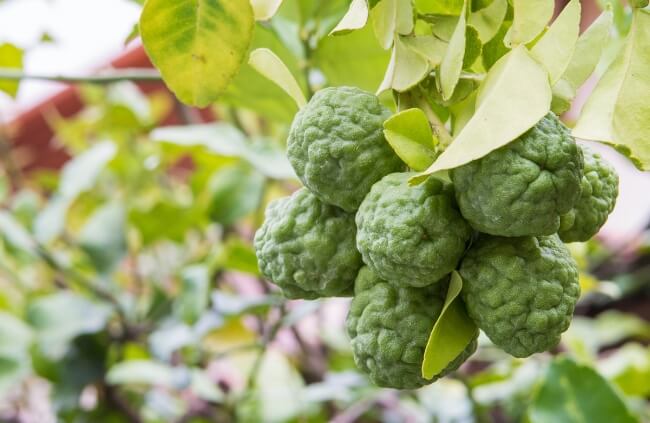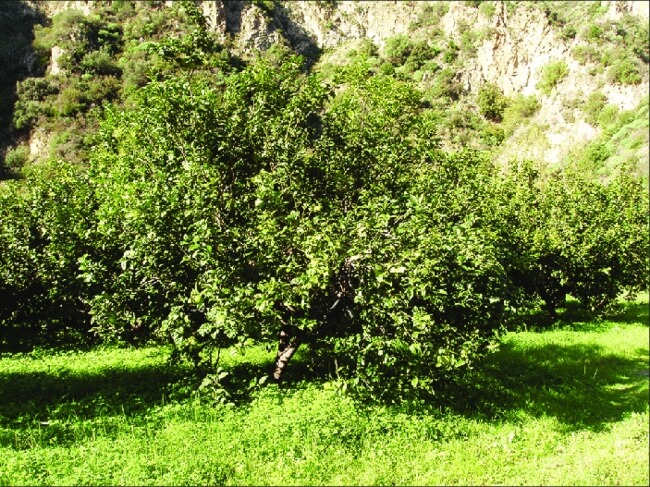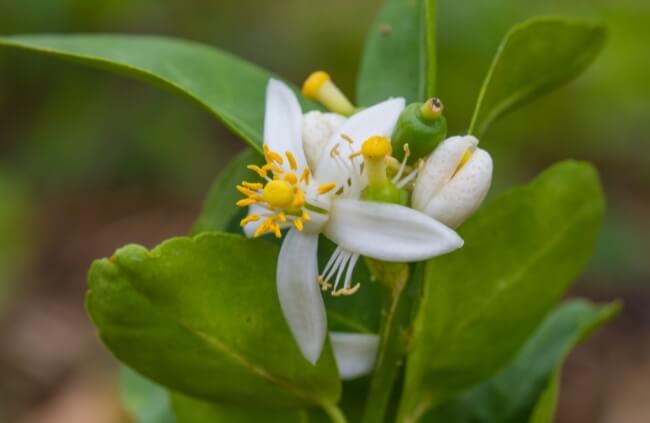My discovery of the Bergamot orange or Citrus bergamia, began with a cup of Earl Grey tea. Intrigued by my daily cup of happiness, I enthusiastically researched this small citrus tree and the fragrant fruit which is used to create bergamot oil.
In this article, I will share with you what I have learned about propagating Bergamot, what kind of care is needed for the tree, and how to harvest the fruit.
More...

Family: | Rutaceae |
|---|---|
Genus: | Citrus |
Species: | C. bergamia |
Common Names: | Bergamot, Bergamot Orange |
Origin: | Southern Italy |
Location: | Indoor and outdoor |
Type: | Tree |
Growth: | Up to 4 metres tall and 3 metres wide |
Sun requirements: | Full sun |
Foliage Colour: | Dark green |
Flower Colour: | White |
Flowering: | Spring |
Edible Parts: | Fruit |
Maintenance level: | Average |
Poisonous for pets: | Yes |
Introduction to Bergamot Trees
The Bergamot tree began its life in southern Italy, and got its name from the town Bergamo. Now it’s grown in other parts of the Mediterranean for the delightful fruit which turns bright yellow when it’s ripe.
Citrus bergamia or Bergamot orange is a hard working tree. It can produce fruit for up to 60 years! This fruit is like gold. It’s used to create perfume and essential oil (similar to ylang ylang) which is extracted from the peel. The fragrance is delightful and I find it puts me in a happy mood.
The history of Bergamot orange fruit actually begins in the 1700s. Giovanni Maria Farina created the first Eau de cologne using infused bergamot oil and distilled alcohol. I discovered that to make just 50 grams of bergamot oil, you need 100 kilograms of Bergamot fruit.
Thank goodness for modern inventions because the original method of extracting the oil was to press the fruit by hand. Nature is truly amazing if you think that Bergamot has more than 360 different chemical compounds. It’s full of antioxidants and all kinds of other beneficial ingredients that have earned it the title of a super food.
How to Grow Bergamot Tree in Australia

Source: ResearchGate
Bergamot Orange Ideal Planting Conditions
Since Bergamot Orange grows so perfectly in Italy (I mean, I would too), you would expect a limited climate range. The tree also does well in a subtropical climate, with a mild winter and warm summer.
Strong winds are a big no as the tree has delicate branches and leaves. Good sun exposure is key for the Bergamot orange. That means 6 to 8 hours of direct sunlight every day.
First prize would be a loamy soil that is well-draining. For clay or sandy soil, add compost or manure to help with drainage. Potassium and phosphorus are important nutrients for Bergamot oranges. A pH level that is slightly acidic to neutral is ideal.
How to Propagate Bergamot Orange Trees
Bergamot Tree Propagation from Cuttings
The beginning to middle of summer is the ideal time to propagate Citrus bergamia from cuttings. I suggest taking a 20 cm softwood cutting early in the morning. Make sure the cutting doesn’t have flowers and take off the bottom leaves.
You can leave about 3 leaves at the top. Give the cutting another trim to around 15 cm and cut just below a leaf node. Prep your pot and compost.
Before planting the cutting, dip it into some rooting hormone powder. Water the cutting and then pop it somewhere warm and bright but not directly in the sun. The compost needs to stay moist.

Propagating Bergamot Trees from Seeds
To propagate Bergamot orange from seed, do this any time from the beginning of spring to the end of winter. Once you have sourced your fresh seed, soak them in warm water for 24 hours. This will soften the seed coat and help with germination.


Get Your Free Guide:
Master Growing Australian Natives eBook
A Must Have Complete Guide for Every Australian Garden
Get Your Free Guide:
Master Growing Australian Natives eBook
A Must Have Complete Guide for Every Australian Garden
Next, take sandpaper with a fine grit and gently rub the seeds. Choose a suitable potting mix that is well draining and fill the pots or trays. What’s most important about the mix you choose is that it doesn’t get waterlogged.
Plant the seeds just over a centimetre deep and space them about 5 cm apart. Cover the seeds with a bit of mix and press it down. Pop the pots somewhere warm. Maintaining a temperature between 21 and 27°C is the sweet spot for the seeds. Cover the pots with some plastic wrap to increase humidity.
The Bergamot orange seeds take between 2 and 8 weeks to germinate and the potting mix needs to stay moist. Seeing the first leaves is always exciting. Once there are a few sets of leaves and the seedling seems strong enough, transplant it into its own pot.
It’s now time to increase the light exposure. The seedlings should be in a sunny spot to soak up as many hours as possible in a day. To nurture these new seedlings, they will need water often to keep the soil moist.
Fertiliser is recommended every 4 to 6 weeks and pruning of any weak branches. Before these new beauties can move outdoors permanently, they need some time to adjust. Expose the seedlings to more and more sunlight for about 2 weeks.
When the seedling is ready to move to its forever home, choose a sunny spot with well-draining soil.
Caring for Citrus Bergamia
Watering Schedule
Water Citrus bergamia often and particularly when it’s in the growing season. The soil should be left to dry out between each watering session as too much water can cause root rot. Mulching around the tree base with straw or wood chips can lock in moisture and keep the weeds out.
Fertiliser to Use
Bergamot oranges need feeding at the start of spring with a balanced citrus fertiliser and again at the end of spring and end of summer.
Pruning Bergamot Trees
Pruning is good for Citrus bergamia to keep it in shape and allow for air circulation. Get rid of dead branches at the end of winter or start of spring before any new growth happens. Pruning tools should be clean and sharp.
Harvesting Bergamot Oranges

Harvest Bergamot orange when the fruit is completely ripe. It should be bright yellow and have a soft texture. Just remember that once the fruit has been harvested, it won’t ripen anymore. When harvesting, check the tree for any damage or pests and prune them out.
Use pruning shears that are sharp and clean to cut the fruit off at the stem, just over a centimetre above the fruit. Don’t pull or twist the fruit off the tree as it might cause damage. The rind of Citrus bergamia is fragile and can end up bruised.
When harvesting the fruit, place them in a single layer so they don’t crush each other.
How to Store Bergamot Oranges
Store Bergamot orange somewhere cool and dry and away from direct sun. If the fruit is going to be enjoyed within a few days, store the fruit at room temperature.
For a longer shelf life, pop the fruit in a plastic bag and store in the fridge. If stored correctly, the Citrus bergamia fruit won’t lose any flavour or aroma.
Common Bergamot Pests and Diseases
Alternaria brown spot
Bergamot fruit infected by this fungus changes colour and dark markings appear on the younger tree branches, leaves and fruit. One of the best prevention methods is to avoid watering from above and provide the tree with enough fertiliser.
Black spot
The fruit rind of the Bergamot orange will look spotty or speckled. Fruit might start dropping off the tree before it’s ripe but there might also be less fruit overall. Black spot fungus thrives in areas that have summer rainfall, and the spores travel on the wind but also in splashed water. A copper based fungicide works well for treatment.
Powdery mildew
The powdery mildew fungus looks just like white powder on the leaves. Any new growth on the tree is usually off colour and often the leaves start to fall and the fruit drops prematurely. This fungus likes cool and damp conditions.
I discovered that baking soda combined with liquid soap and water is the best homemade and organic fungicide to treat powdery mildew.
Bergamot Frequently Asked Questions

Does Bergamot oil have any health benefits?
There are plenty of studies about the benefit of using bergamot oil. It has been used to reduce stress, treat food poisoning, lower cholesterol, and reduce pain and inflammation.
Is Bergamot a type of hybrid plant?
The tree is considered a hybrid, either between sour orange and lemon, or a hybrid between sour orange and lime.
What are the different groups of Bergamot when it comes to the fruit?
Melarosa is the most common and the fruits are flattened. The Torulosa group has fruit with ridges on the rind, and the Piccola group is a dwarf type of fruit.
Do you get different varieties of Bergamot?
There are three varieties - Castagnaro, Femminello, and Fantastico.
- Fantastico produces the best quality essential oil and is the most widely available cultivar. It has large leaves and smooth pear shaped fruit.
- Castagnaro is a hardy cultivar and the fruit has a thick and rough skin.
- Femminello is not as productive as the other cultivars and has smaller fruit and a thinner skin. It is however less climate sensitive.
What kind of flavour does Bergamot orange have?
I would describe the flavour as sweet and sour and a little bitter. It’s very different from other citrus fruits. The flavour combo of Citrus bergamia makes it refreshing and it smells good too. The sweet is subtle, the sour is zesty, and the bitterness is not overpowering. Imagine a grapefruit but even milder.
How can you use Bergamot with food?
It can be used to add flavour to desserts, baked goods, and of course, tea. The acidic juice from the fruit can be used as a substitute for vinegar or lime juice.
Wrapping Up Our Bergamot Tree Guide
I would love to go and drink a cup of Earl Grey tea in Italy, the country that produces more Bergamot orange than any other place globally. Calabria in southern Italy in particular, is a unique growing region that consistently produces top quality essential oil. Time to plan my next adventure.
Published on November 9, 2023 by Lorri Hopkins
Last Updated on February 25, 2024




